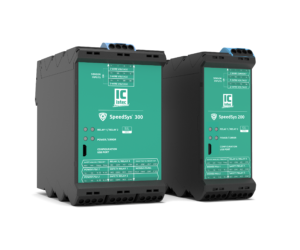« Back to product page of SpeedSys 200
« Back to product page of SpeedSys 300
General FAQs
SpeedSys ODS is the collective name for the SpeedSys 200 and SpeedSys 300, which are part of the SpeedSys product line which also consists of the SpeedSys tachometers T10, T20 & T30. SpeedSys ODS are a SIL-rated overspeed detection system (ODS) with ATEX-certified input circuitry and can be integrated in SIL-rated decision chains, like emergency shutdown systems.
- SIL3 in a setup with HFT ≥ 1 (1oo2, 1oo3 or 2oo3)
- Binary input (for remotely triggering a test and/or reset)
- Binary output
- Modbus RTU RS-485 (read-only)
To feature flexibility and easy retrofitting SpeedSys ODS works with the three most commonly found sensors in the field: MPU/VR, Hall effect and eddy current/proximity.
SpeedSys 200
Overspeed, acceleration and underspeed. All of these can be simultaneously configured to all four relays. This allows for maximum configuration flexibility
SpeedSys 300
Overspeed, acceleration and underspeed. All of these can be simultaneously configured to all four relays and the binary output (SpeedSys 300 only). This allows for maximum configuration flexibility
SpeedSys 200
By periodically testing (parts of) a system the PFD (probability of failure of demand) is reduced, leading to higher reliability. SpeedSys 200 allows for proof testing of tailing equipment by switching its relays through the software. The transmitter itself has a typical proof test interval of ≥ 10 years.
SpeedSys 300
By periodically testing (parts of) a system the PFD (probability of failure of demand) is reduced, leading to higher reliability. SpeedSys 300 allows for proof testing of tailing equipment by switching its relays through the software or activating the binary input. The transmitter itself has a typical proof test interval of ≥ 10 years.
The sensor cable lengths are not defined by the SpeedSys transmitter, but by the sensor, application specifics and the electromagnetic environment.
The standard maximum length for USB 2.0 is 5 m (16 ft).
No, the sensor input circuitry of the SpeedSys 200 is ATEX certified (zone 0 & 20). This gives the hardware the advanced ability to monitor the sensors and detect sensor failure. With external barriers this is not always possible.
A configuration file can be prepared ‘off-line’ after which this can be uploaded onto a powered SpeedSys unit.
The configuration of the commissioned unit needs to be uploaded to the replacing unit after that the units can be swapped without interrupting the power.
Yes, SpeedSys ODS has a redundant power input. These inputs are internally connected by ORing diodes after which the main power supply is checked to be from 18 to 36 VDC. Therefore SpeedSys ODS will work fine on a single power input, but also no alarm is raised if just one power input fails.
The SpeedSys modules are mounted on a DIN rail, but a 19” rack adapter is available.
No, the password in SpeedSys ODS can only be set by the manufacturer. Be careful!
No, SpeedSys ODS is part of the critical protection of the machine and can therefore only be programmed by authorized personnel.
It is our intention always to have a sufficient stock supply resulting in a delivery time of 1-2 weeks. For larger quantities please inquire with sales@istec.com.
SpeedSys 300 specific FAQs
The proof test can be activated remotely on the SpeedSys 300, but not through the MODBUS. SpeedSys 300 has a special binary input.
Yes, every transmitter gets a unique address (max. 247 per MODBUS line) within the MODBUS protocol from which information can be requested.
No, SIL3 protection can only be obtained with a system with a hardware fault tolerance of 1 or higher (HFT ≥ 1)

